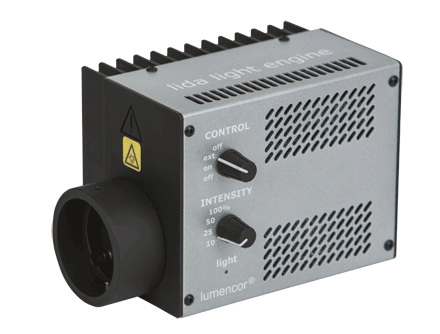|
Wednesday, March 22, 2017
|
|

|
|
|
Monthly newsletter focusing on how light-based technologies are being used in the life sciences. Includes news, features and product developments in lasers, imaging, optics, spectroscopy, microscopy, lighting and more.
|
|
|
|
sponsor
|

|
|
Near-Infrared Spectroscopy Probes Food Freshness
Near-infrared (NIR) spectroscopy is well-suited to analysis of bulk, high-moisture agricultural samples such as fruit, grains, fish and meat. Light at NIR wavelengths penetrates samples with less scattering than other techniques, allowing internal composition to be analyzed nondestructively. Although NIR spectra are often broad, overlapping and complex, statistical modeling can be used to unlock their secrets.
|
|
|
|
|
|
Photobiomodulation Therapy Comes of Age
Important advances in our understanding of the basic science of photobiomodulation (PBM) are influencing the development of laser technology and the use of these devices to treat a number of diseases and injuries. PBM is the mechanism by which non-ionizing optical radiation in the visible and NIR spectral range is absorbed by endogenous chromophores to elicit photo-physical and photo-chemical events at various biological scales.
|
|
|
|
|
|
 New Treatment for Inflammatory Disease Uses Optogenetic Tool
New Treatment for Inflammatory Disease Uses Optogenetic Tool
An optogenetic approach to regulating inflammation and immunity in the human body employs photocontrolled inhibitors that are selectively delivered to the target cells via UV radiation. This novel approach could further the study of inflammation and the immune system, and could ultimately lead to a means to control inflammation in vivo, while minimizing side effects to healthy tissues.
|
|
|
|
|
|
Graphene-Laced Silly Putty Creates Sensors
By infusing silly putty (polysilicone) with graphene, researchers have produced an extremely sensitive sensor they call “G-putty.” They found that when the graphene was added, the silly putty was able to conduct electricity and became very sensitive to deformation and impact.
|
|
|
|
|
|
A new high-tech tiny imaging probe encased with a brain biopsy needle could make brain surgery safer. Researchers from the University of Adelaide developed the medical device that will let surgeons "see" at-risk blood vessels as they insert the needle.
|
|
|
|
Medical technology developer Medtronic PLC has announced that its Visualase MRI-guided laser ablation system has been performed in the Stereotactic Laser Ablation for Temporal Lobe Epilepsy (SLATE) clinical trial at the Mayo Clinic in Rochester, Minn.
|
|
|
|
 Lumencor's LIDA Light Engine
Lumencor's LIDA Light Engine
Lumencor Inc.
Lumencor’s LIDA light engine® works hand-in-hand with the latest monochrome cameras to generate RGB color transmitted light images with unprecedented sensitivity, spatial resolution, speed and color fidelity.
Visit Website
Request Info
|
|
|
|
|
|
 Light Sheet Microscopy (oSPIM)
Light Sheet Microscopy (oSPIM)
Applied Scientific Instrumentation Inc.
ASI’s Oblique Single Illumination Microscope (oSPIM) is an excellent platform for high resolution light sheet microscopy for samples mounted in standard coverslip-bottom culture dishes.
Visit Website
Request Info
|
|
|
|
|
Large-Scale, Deep-Tissue Neuronal Imaging
Thu, Apr 20, 2017 1:00 PM - 2:00 PM EDT
Lingjie Kong, Ph.D., will speak on advances in large-scale deep tissue imaging of biological dynamics, focusing on applications in neuroscience. Kong received his Ph.D. in Optical Engineering from Tsinghua University in 2012. For postdoctoral training, he worked at X. Sunney Xie's group at Harvard University, Meng Cui's group at Howard Hughes Medical Institute's Janelia Research Campus and Purdue University. He is currently engaged in research work at Purdue University and is planning to join the faculty at Tsinghua University.
|
|
|
|
Introducing the CAOS Smart Camera - Empowering Extreme Imaging
Wed, Apr 26, 2017 1:00 PM - 2:00 PM EDT
Nabeel A. Riza, Ph.D., chair professor of Electrical and Electronic Engineering at University College Cork, will discuss the development of the Coded Access Optical Sensor (CAOS) and how the CAOS sensor, working in unison with CMOS sensors, can smartly extract scene contrast pixel light intensity information using time-frequency coding of selected agile pixels. He will discuss how CAOS addresses the challenges to reaching extreme all-linear, instantaneous dynamic ranges with multicolor smart capture of targets of interest within extreme contrast images and provide a demonstration of a version of CAOS called the CAOS-CMOS camera. Who should attend: engineers, scientists, researchers and technical professionals who may require or are interested in extreme contrast imaging.
|
|
|
|
Features
Raman Tissue Analysis; Point-of-Care Imaging; Lasers for Photodynamic Therapy (Photochemical Reactions); Surgical Microscopes
Issue Bonus
Annual Laser Sourcebook: Research, Market Report, and Directory
Photonics Media is currently seeking technical feature articles on a variety of topics for publication in our magazine BioPhotonics. Please submit an informal 100-word abstract to Associate Managing Editor Marcia Stamell at marcia.stamell@photonics.com or use our online submission form www.photonics.com/submitfeature.aspx.
|
|
|
 BioPhotonics is the global resource for research, business and product news and information for the biophotonics community and the industry's only stand-alone print and digital magazine.
BioPhotonics is the global resource for research, business and product news and information for the biophotonics community and the industry's only stand-alone print and digital magazine.
Stay current with a FREE subscription, and expand your knowledge of light and the life sciences through our extensive, industry-specific archives.
View Digital Edition
Subscribe Free
|
|
|
|
|